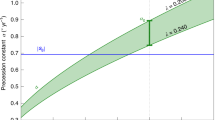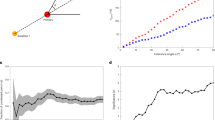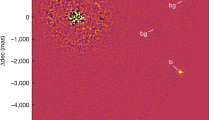Abstract
The giant planets in the Solar System each have two groups of satellites. The regular satellites move along nearly circular orbits in the planet's orbital plane, revolving about it in the same sense as the planet spins. In contrast, the so-called irregular satellites are generally smaller in size and are characterized by large orbits with significant eccentricity, inclination or both. The differences in their characteristics suggest that the regular and irregular satellites formed by different mechanisms: the regular satellites are believed to have formed in an accretion disk around the planet, like a miniature Solar System, whereas the irregulars are generally thought to be captured planetesimals1. Here we report the discovery of 12 irregular satellites of Saturn, along with the determinations of their orbits. These orbits, along with the orbits of irregular satellites of Jupiter and Uranus, fall into groups on the basis of their orbital inclinations. We interpret this result as indicating that most of the irregular moons are collisional remnants of larger satellites that were fragmented after capture, rather than being captured independently.
This is a preview of subscription content, access via your institution
Access options
Subscribe to this journal
Receive 51 print issues and online access
$199.00 per year
only $3.90 per issue
Buy this article
- Purchase on Springer Link
- Instant access to full article PDF
Prices may be subject to local taxes which are calculated during checkout

Similar content being viewed by others
References
Peale, S. J. Origin and evolution of the natural satellites. Annu. Rev. Astron. Astrophys. 37, 533–602 (1999).
Gladman, B. J. et al. Discovery of two distant irregular moons of Uranus. Nature 392, 897–899 (1998).
Gladman, B. J. et al. The discovery of Uranus XIX, XX, and XXI. Icarus 147, 320–324 (2000); erratum 148, 320 (2000).
Marsden, B. G. S/1999 J 1. IAU Circ. 7460 (2000).
Marsden, B. G. S/1975 J 1 = S/2000 J 1. IAU Circ. 7640 (2000).
Green, D. Satellites of Jupiter. IAU Circ. 7555 (2001).
Pollack, J. B., Burns, J. A. & Tauber, M. E. Gas drag in primordial circumplanetary envelopes: A mechanism for satellite capture. Icarus 37, 587–611 (1979).
Colombo, G. & Franklin, F. A. On the formation of the outer satellite groups of Jupiter. Icarus 30, 186–189 (1971).
Heppenheimer, T. A. & Porco, C. C. New contributions to the problem of capture. Icarus 30, 385–401 (1977).
Saha, P. & Tremaine, S. The orbits of the retrograde jovian satellites. Icarus 106, 549–562 (1993).
Hénon, M. Numerical exploration of the restricted problem. VI. Hill's case: Non-periodic orbits. Astron. Astrophys. 9, 24–36 (1970).
Hamilton, D. P. & Burns, J. A. Orbital stability zones about asteroids. Icarus 92, 118–131 (1991).
Hamilton, D. P. & Krivov, A. V. Dynamics of distant moons of asteroids. Icarus 128, 241–249 (1997).
Wiegert, P., Innanen, K. & Mikkola, S. The stability of quasi satellites in the outer solar system. Astron. J. 119, 1978–1984 (2000).
Kozai, Y. Secular perturbations of asteroids with high inclination and eccentricity. Astron. J. 67, 591–598 (1962).
Kinoshita, H. & Nakai, H. Secular perturbations of fictitious satellites of Uranus. Celest. Mech. 52, 293–303 (1991).
Clark, R. N., Fanale, F. P. & Gaffey, M. J. in Satellites (eds Burns, J. A. & Matthews, M. S.) 437–492 (Univ. Arizona Press, Tucson, 1986).
Luu, J. CCD photometry and spectroscopy of the outer jovian satellites. Astron. J. 102, 1213–1225 (1991).
Jarvis, K. S. et al. JVI Himalia: New compositional evidence and interpretations for the origin of Jupiter's small satellites. Icarus 145, 445–453 (2000).
Farinella, P. et al. The injection of asteroid fragments into resonances. Icarus 101, 174–187 (1993).
Smith, B. A. et al. A new look at the Saturn system. Science 215, 504–537 (1982).
Colwell, J. E. & Esposito, L. W. Origins of the rings of Uranus and Neptune. II. Initial distributions of disrupted satellite fragments. J. Geophys. Res. 98, 7387–7401 (1993).
Porco, C. C. et al. in Neptune and Triton (ed. Cruikshank, D. P.) 703–804 (Univ. Arizona Press, Tucson, 1995).
Tanga, P. et al. On the size distribution of asteroid families: The role of geometry. Icarus 141, 65–78 (1999).
Thomas, P. et al. Phoebe: Voyager 2 observations. J. Geophys. Res. 88, 8736–8742 (1986).
Simonelli, D. et al. Phoebe: Albedo map and photometric properties. Icarus 138, 249–258 (1999).
Gladman, B. et al. Pencil-beam surveys for faint trans-neptunian comets. Astron. J. 116, 2042–2054 (1998).
McKinnon, W., Lunine, J. I. & Banfield, D. in Neptune and Triton (ed. Cruikshank, D. P.) 807–878 (Univ. Arizona Press, Tucson, 1995).
Marsden, B. G. S/2000 S 1 and S/2000 S 2. IAU Circ. 7512 (2000).
Marsden, B. G. S/2000 S 3 and S/2000 S 4. IAU Circ. 7513 (2000).
Marsden, B. G. S/2000 S 5 and S/2000 S 6. IAU Circ. 7521 (2000).
Marsden, B. G. S/2000 S 7, S/2000 S 8 and S/2000 S9. IAU Circ. 7538 (2000).
Marsden, B. G. S/2000 S 10. IAU Circ. 7539 (2000).
Green, D. S/2000 S 11. IAU Circ. 7545 (2000).
Green, D. S/2000 S 12. IAU Circ. 7548 (2000).
Acknowledgements
The Canada–France–Hawaii telescope is operated by the National Research Council of Canada, le Centre National de la Recherche Scientifique de France, and the University of Hawaii. Observations for the ESO 2.2-m telescope and the VLT were collected at the European Southern Observatory, Chile. Observations at the Palomar Observatory were made as part of a continuing collaborative agreement between the California Institute of Technology and Cornell University. Kitt Peak National Observatory, part of the National Optical Astronomy Observatories, is operated by the Association of Universities for Research in Astronomy, Inc. (AURA) under cooperative agreement with the National Science Foundation. The Nordic Optical Telescope is operated on the island of La Palma jointly by Denmark, Finland, Iceland, Norway and Sweden, in the Spanish Observatorio del Roque de los Muchachos of the Instituto de Astrofisica de Canarias. We gratefully acknowledge financing from the French Research Ministry ACI Jeunes Chercheurs programme, the Institut National de Science de l'Univers, from the European Southern Observatory, from the NASA Planetary Astronomy programme and the Natural Sciences and Engineering Research Council of Canada.
Author information
Authors and Affiliations
Corresponding author
Rights and permissions
About this article
Cite this article
Gladman, B., Kavelaars, J., Holman, M. et al. Discovery of 12 satellites of Saturn exhibiting orbital clustering. Nature 412, 163–166 (2001). https://doi.org/10.1038/35084032
Received:
Accepted:
Issue Date:
DOI: https://doi.org/10.1038/35084032
This article is cited by
-
Secular resonances between bodies on close orbits II: prograde and retrograde orbits for irregular satellites
Celestial Mechanics and Dynamical Astronomy (2017)
-
Small particles dominate Saturn’s Phoebe ring to surprisingly large distances
Nature (2015)
-
Irregular Satellites of Jupiter: a study of the capture direction
Earth, Moon, and Planets (2007)
-
Irregular Satellites in the Context of Planet Formation
Space Science Reviews (2005)
-
Discovery of five irregular moons of Neptune
Nature (2004)
Comments
By submitting a comment you agree to abide by our Terms and Community Guidelines. If you find something abusive or that does not comply with our terms or guidelines please flag it as inappropriate.



